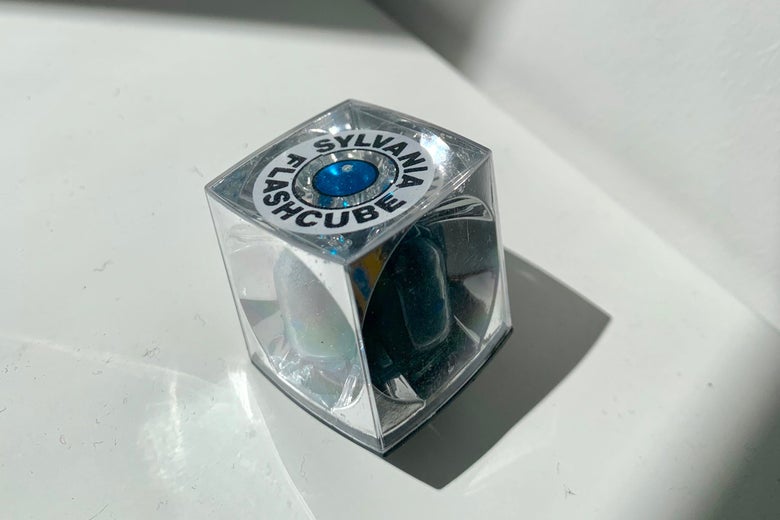How the item improved domestic images.
6 min read
Slate has interactions with different on the net shops.
If you get some thing via our backlinks,
Slate may possibly make an affiliate fee.
We update one-way links when probable,
but observe that deals can expire and all prices are matter to modify.
All charges had been up to date at the time of publication.
The Kodak Flashcube—a rotating cube with a miniature flashbulb incarcerated inside of each of its four mirrored compartments—made novice pictures of the domestic interior attainable from the mid-1960s onwards. It also lowered the risk of damage introduced by its forebears. Its mother, the single-use luminescent flashbulb, resembled a domestic light bulb and would job shattered glass as perfectly as mild. Its fragility disguised its ferocity. Containing magnesium filaments, the oxygen gasoline, the moment electrically ignited by the click on of the camera shutter, would deliver considerable residual heat and usually result in unpleasant burns. Recollections should melt away brightly, not painfully. The Flashcube’s grandmother, the flash lamp, carried an even bigger chance of violence. Upon triggering the shutter, both photographer and issue risked being minimize or even blinded must some stray glass enter the eye. Worse, photographers in some cases died when getting ready the flash powder, a composition of metallic gas and an oxidizer this kind of as chlorate. Flash lamps maintained their industry dominance for some sixty decades in advance of flashbulbs changed them in 1929. In 1965, having said that, the need for bigger safety and simplicity urged the Flashcube into existence.
Eastman Kodak’s invention of the Flashcube also emerged from the company’s distinct desire to provide a flash that would do the job with its newly ubiquitous novice photographers’ cameras, made well-known by the white center-course people qualified in 1960s marketing campaigns. Partnered with Kodak’s Instamatic camera, the Flashcube’s adaptability, portability, and simplicity of use designed inside photography achievable for the masses, with no prerequisite skill or experience. The influence on interior habits as effectively as inside areas was significant. Interiors and normative domestic relations could be captured and shared, exposing the aspirational aesthetics and social arrangements of this once most private of architectures. In magazine adverts, a woman’s hand was revealed affectionately caressing a Flashcube, positioning it as a female technological innovation to seize residence everyday living. In the Flashcubes’ dazzling gentle, families staged domestic tableaux in an hard work to display their nuclear relatives credentials.
In observing the phenomenon of staging, Susan Sontag observed presciently that “needing to have fact verified and working experience enhanced by images is an aesthetic consumerism to which every person is addicted.” And, since habit is characterised by repetition, Flashcube “users” could click on/shoot, click/shoot, click on/shoot, click on/shoot, discard, reload, click on/shoot, click on/shoot, simply click/shoot, click on/shoot, discard, reload and so on, right until the three-pack was put in. Without having agency more than mild amounts, distinction or glare, redeye was inescapable, casting an unintentionally malevolent air over numerous tableaux. And with each individual photograph, the Flashcube would make a modest snapping sound, as sharp and discreet as a breaking wishbone. The four- compartment casing would come to feel heat for an instant, then chilly, and then endlessly silent. With each aluminium ignition the Flashcube’s explosion remained contained in just its inside, the plastic housing intact. The topics would freeze in anticipation, to prevent the impression staying blurred, only to disperse their familial tableau seconds afterwards, momentarily blinded.
If they at any time appeared at the used Flashcube just before discarding it, subjects would have observed the scorch marks within, resembling the remnants of a chip-pan hearth in a doll’s property. Aluminum, the element in the Flashcube that helps the magnesium combust, should be a single of the crucial product symbols of modernity, owning shaped the twentieth century by way of domestic and industrial improvements, air electrical power and Moon landings. It is lightweight, robust, non-magnetic and resistant to corrosion. But aluminum’s shiny utopia has a darkish aspect. Aluminum is a neurotoxin that, when ingested, may bring about Alzheimer’s.* That an object created to seize memories is contrived from a substance that corrodes memories speaks of equally alchemy and irony. Aluminum in its uncooked sort is contrived from bauxite, an amorphous clayey rock whose strip-mining extraction requires the elimination of all indigenous vegetation in the surrounding area, the destruction of habitat and food stuff for community wildlife, with soil erosion and river pollution thrown in. Considering the fact that they very first opened, bauxite mines have fueled source disputes in Africa, India and the Caribbean, and have elicited equally the greed and the wrath of multinational organizations. Aluminum embodies the carcinogenic contradiction of our time: that affordable, playful and effortless consumerism is non-degradable toxic waste in waiting. Most likely this is the reality that the spent Flashcube illuminates greatest.
None of this was on the sign up of shoppers at the time, of class. They only wished a flash that wouldn’t die right after remaining fired only the moment. The answer was in point remaining created as early as 1931, thirty years before the Flashcube, by Harold Edgerton, a professor of electrical engineering. His Electronic Flash, a battery-driven system able to have its have vitality supply and built-in into the digital camera body, commenced to dominate the shopper market in the late 1960s. It was correctly suited to many makes use of with out the detriment of detritus, and speedily deposed the Flashcube as the gadget of decision for capturing domestic interiors. Therefore, the Flashcube’s principal producer, the Kodak subsidiary Sylvania Electrical Products and solutions, ceased creating it in the 1970s. As a major contractor for warfare investigate and other varieties of surveillance, the corporation returned to its principal product or service strains, principally, avionics systems for observation helicopters, and individual distress radios for downed pilots.
Inspite of the closed output line, is it disingenuous to assert that Flashcubes are extinct? What about the familial reminiscences they captured? As Sherry Turkle observes, “we consider objects as helpful or aesthetic, as necessities or vain indulgences … [but] are on considerably less common floor when we take into account objects as companions to our emotional life or provocations to believed.” A Flashcube’s aluminum filament can take 1 hundred a long time to decompose, and its plastic casing up to a thousand. Nonetheless, the photographic prints it created will degrade within 50 % a century, generating the interior, familial recollections that the Flashcube helped to seize significantly more inclined to disposability than the item employed to build them. For that reason the Flashcube’s straightforward provocation reveals that self-importance and violence are essential accompaniments to un-disposability. It may have fallen out of use, but the deserted and little by little degrading Flashcube acts as a dimly pulsating warning mild, reminding us that the objects we design to indulge our narcissistic fumbling to immortality only serve to conclude our lifestyle, relatively than increase it.
Correction, Dec. 22, 2021: This reprinted excerpt originally overstated the connection in between the ingestion of aluminum and Alzheimer’s.
Reprinted with authorization from Extinct: A Compendium of Obsolete Objects, edited by Barbara Penner, Adrian Forty, Olivia Horsfall Turner, and Miranda Critchley (Reaktion Publications, $40.00, available from the University of Chicago Press).
For another obsolete item from the book, The Clapper, click in this article.



/cloudfront-us-east-1.images.arcpublishing.com/gray/T2YAJ4NK4BCDHD5S6BVZZTDIYQ.jpg)

